Meet The Award-Winning Commercial Photographer Who Captured The Humanity Of His Hasidic Subjects
Hasidic Jews are often seen as fodder for controversial television shows like Unorthodox or in everyday life as a community that’s completely foreign to the onlooker. Justin Bettman, an LA-based commercial, editorial, and fine art photographer, whose clients include Nike, Google, Spotify, Atlantic Records, New York Times and more set out to change that. He created a positive portrait series on Hasidim which shows the human-side to the community that seems so different on the surface.
Justin grew up in a Reform household and said when he took note of the Hasidic community when he moved to New York City, he felt like it looked like a separate religion. It struck him and he wondered, “how are we similar?” He set out to bridge the gap between Jews of all different backgrounds. Taking up-close and personal photos of members from the Hasidic community was his way of building a connection.
Most photos taken of Hasidic Jews tend to be in a photojournalistic style, which is a way to “observe people” through a lens. The photos are taken without the subject’s consent, and they are often unaware that a photo is being taken. As a result, the photos tend to feel cold and distant when “the shtreimels are captured from far away,” Justin says. He took the opposite approach and sought consent, making his subjects aware that he would be taking portraits of them. Justin says he “wanted it to be more of a conversation, and he just took a photo while doing it.” He continues, “I got to touch it (the shtreimel) and feel it and wear it, and for me that was part of the project.”
While he ended up with many participants, it was harder to get started because many Hasidim did not want their photos taken. Justin learned that Hasidim were apprehensive because “a lot of people (from their community) have been portrayed negatively” in the media. “It is hard for a community to be portrayed positively if they are not willing to let people take their pictures or have that discussion,” Justin explains. So, it ends up being “a complicated situation” because the uplifting and positive stories do not get told.
The Netflix series, Unorthodox, which tells the story of a Satmar girl leaving the community, came out when Justin was deep in this project. He asked some of the Hasidim that he was photographing how accurate the show was and they said while the traditions and garb were spot on, the show “definitely got some things wrong.” Historically, the stories told about the Hasidic world tend to be about an ex-community member’s personal experience that included various levels of trauma. According to Justin’s subjects, Unorthodox “seemed to be a fairly accurate depiction of at least this one person’s experience” who went through trauma while living within the Satmar community.
Before the portrait series, Justin had his preconceived notions about the Haredi world because they lived in one bubble, while he lived a completely separate life. To his surprise, he learned that the Hasids are “open and familiar with the secular world” and as he got to know them, he began to see them “in a more favorable light.” Justin says he found their strong “sense of community admirable and liked how much people are connected.”
When Justin uploaded his project online, he says he was “expecting to get some antisemitic comments, because the worst kinds of people come out of the woodwork online,” but that surprisingly, it wasn’t the case. He received a great deal of positive feedback and he found people to be “super supportive.” But, the one thing people questioned was the lack of female portraits in his series. Justin states that he did photograph women, but they were not “comfortable having their portraits portrayed publicly.”
Justin believes it is “important for any group of people or race to have their story told” and that more positive content about the Hasidic community will counterbalance the negative stories that are already out there. Justin concludes, “if there are more ways for people to share things about their lives and why they enjoy it, hopefully it will change the perspective of others.”
To view the entire Hasidic series, click here.
If you found this content meaningful and want to help further our mission through our Keter, Makom, and Tikun branches, please consider becoming a Change Maker today.









